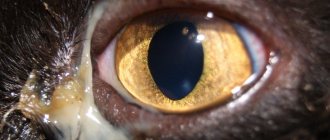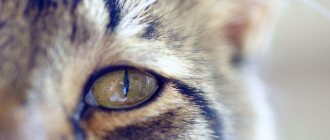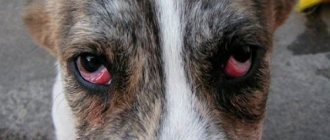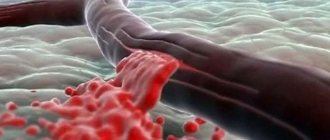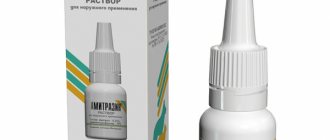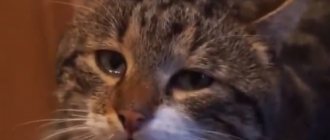Taking care of our pets is the least we can repay them for their devotion and selfless love. Everyone who has a cat in their home is concerned about its well-being and health, because the animal itself cannot tell us where and what hurts. Therefore, the longevity of your pet lies entirely on your shoulders, it is your responsibility.
If you notice that your cat's eyes are running, changes in her behavior, it seems to you that she is lethargic, has a poor appetite and shows apathy towards the world around her, then you should take a closer look at her. Is this a serious illness or a temporary phenomenon? Do you need to urgently run to the veterinarian or is what is happening to your pet a normal natural process that has nothing to do with potential illnesses? We will discuss what to do and how to alleviate your pet’s condition further.
Symptoms - how to understand that your cat is sick.
There are many unpleasant diseases that can affect your pet's vision. It is important to recognize them in time and seek qualified help, because the lack of treatment or untimely intervention by a specialist will aggravate the situation and even lead to complete or partial loss of the pet’s vision.
You should be seriously concerned about the condition of your furry friend if you notice the following symptoms:.
- Brown discharge from a cat's eyes, often mixed with pus, indicates the presence of a bacterial infection in the animal's body. Additional symptoms in this case may include lethargy and nasal discharge.
- Clear discharge, as well as abundant and thick discharge, warns you of a viral infection.
- Brown discharge most often appears when the tear ducts malfunction.
- If a cat has swollen eyes and waters with ordinary tears, without any admixture of pus, but in large quantities, she sneezes and itches, then most likely this is an allergic reaction. This disease is also heralded by redness of the eyelids and their swelling.
- Reddish discharge from the eyes can easily be confused with brown if the cat has a dark fur color.
- Watch his reaction to others - is the cat making contact or has he become unsociable?
- Has his appetite changed?
- Check for scratches and other mechanical damage near the eyes.
- Try to find out what color the discharge from the pet’s eyes is, and whether there is any admixture of pus in it.
Perhaps they are not so pronounced, and it is difficult for you to decide what exactly is bothering your pet. In this case, it is worth observing his behavior.
If all these symptoms are absent in your case, and the cat’s eyes are watering with ordinary transparent tears, then there is no reason to panic. There are a number of reasons why even a healthy animal can have watery eyes. This is an unsuitable diet, characteristics of the breed, an allergic reaction to certain components or substances.
Symptoms of pathology
The nature of the discharge will help determine which disorder contributed to the appearance of the pathological discharge:
- purulent exudate of light brown, yellow or greenish color may indicate bacterial conjunctivitis, keratitis, viral infection and various eye diseases of bacterial origin;
- thick, cloudy mucus: various viral diseases (no discharge of pus is observed);
- milky exudate: cat flu;
- brown discharge: the most common cause is epiphora, which develops as a result of obstruction of the lacrimal ducts (accompanied by dermatitis, hair loss in the eye sockets, itching);
- profuse lacrimation, accompanied by reddening of the whites, frequent blinking, photophobia: allergic reaction, penetration of a foreign body, trauma;
- red liquid: usually this also means brown discharge, but it has a reddish tint in animals of light or white color;
- clear, watery, odorless liquid: normal if lacrimation goes away after a short period of time.
Important! Additional signs of an infectious disease in an animal will be loss of appetite, lethargy, and a dry nose.
Why a cat's eyes are running - possible reasons.
An ordinary healthy cat always secretes a clear liquid secretion from the organs of vision, but it is almost unnoticeable. Those rare cases when a pet exhibits profuse lacrimation are also considered normal. This happens due to the negative influence of external factors such as smoke, dust, harsh lighting or caustic chemicals, and poor hygiene. As a rule, after the cat returns to its normal environment without external stimuli, the production of tears stops.
You should be concerned when a cat develops dark discharge from the eyes, as this is direct evidence of the presence of an infection in the animal’s body. If you notice cloudy, brown, white or red discharge from your pet, immediately seek help from a specialist and do not try to treat the animal yourself at home.
If there is a bacterial infection in the animal’s body, not a viral one, you will notice discharge from the eyes that differs from tears. They can also be white or yellowish in color and cause inflammation in the area.
There are a number of diseases that can cause disruption of the tear ducts in cats:
- This is the formation of tumors and neoplasms that compress the channels.
- Allergy to external irritants or food. This reason is one of the most common.
- Non-infectious inflammation of the lacrimal sac.
- Physical trauma to the eyes.
- A foreign object that has entered the lumen of the lacrimal canal.
- Stenosis of lacrimal openings.
- Narrowing of the tear ducts due to inflammatory processes in the body.
- Infectious conjunctivitis.
- Inflammation of the eyelids.
- Incorrect growth of eyelashes (trichiasis).
- Damage to the cornea.
- Disease of the eye vessels.
- Glaucoma.
- Breed predisposition. Some cat breeds, such as Persian or British, have a brachycephalic skull structure, which causes them to have a shortened tear duct and increased tear production.
- Helminthic infestations.
- Immunity problems. It is most common in kittens and older cats who often have colds, causing them to have excessive watery eyes.
Do not forget that whatever the cause of the disease, prolonged absence of proper treatment will worsen the situation. All this time the animal will experience discomfort. As a result, the cat will begin to scratch the sore eye, scratching it into wounds and increasing the area of infection with microbes.
Prevention
Normally, the animal takes care of its own hygiene. However, if, due to individual characteristics, the pet cannot clean the eye area, then it is recommended to use special lotions that prevent the development of infection.
To protect your cat from pathological discharge, it is enough to follow measures to maintain his general health:
- provide high-quality balanced nutrition;
- get immunized on time;
- keep active;
- protect from contact with sick animals.
Treating a cat at home.
In order to decide how to treat your pet at home and not cause further damage to it, be sure to first consult with a veterinarian. After the necessary tests and a thorough examination, your cat may be prescribed antibacterial or antiviral treatment, as well as drops, antibiotics or special anti-inflammatory ointments. In some cases, the animal is prescribed physical therapy or surgery.
If your cat has constant excessive tearing and there are scabs in the corners of the eyes, or the cat has swollen eyelids, dark discharge with an unpleasant odor, or blurred vision, then you should take her to a specialist. Pay attention to the pet's body temperature and general condition. Fever, lethargy, depression, sneezing, and refusal to feed are all symptoms of the disease that require detailed study.
You should also contact your veterinarian immediately if your cat has a foreign object in its eye. Under no circumstances try to remove it yourself, as without special tools and the necessary skills you will injure the animal.
You don't have to wait to see a specialist and have a positive impact on your cat's well-being. But keep in mind, the following tips will not cure your pet, but will only temporarily and partially alleviate his suffering until the cat is examined by a veterinarian and the appropriate treatment is prescribed.
Normal eye discharge
A cat's vision is much sharper than a human's. It helps her navigate space, hunt, quickly get acquainted with new surroundings and see in the dark.
It is normal for cats to secrete a small amount of clear fluid from their eyes. The discharge is odorless and almost colorless. Its quantity is quite scanty and has a semi-liquid consistency. It helps to cleanse the organs of vision from dust, foreign bodies (crumbs, tiny debris) and other contaminants.
In some cases, increased fluid separation is characteristic of certain breeds. For example, this is typical for Persian cats, in which the normal functioning of the nasolacrimal duct is genetically impaired.
It is also common for your pet to experience excessive tearing after sleep. The result may be an accumulation of so-called “sour marks” in the corners of the eyes, which the cat will remove on its own during hygiene procedures.
How to wash a cat's eyes at home?
Suitable herbal infusions of chamomile, oak bark, and saline solution will help your cat cope with the disease before being examined by a doctor. You can also wash her eyes with an alcohol-free antiseptic solution.
You need to wash your cat's eyes with a cotton swab, from the outer edge to the inner. This must be done very carefully and gently so as not to harm the pet and cause him a minimum of discomfort.
Discharge from the eyes and nose is also treated with special ointments. In some cases, the cat needs to pull back the lower eyelid and put ointment there, for example, tetracycline ointment, novocaine, hydrocartisone drops, levomecitin drops. Keep in mind that it is not recommended to use antibiotics and ointments on your own without a veterinarian's prescription.
Treatment
If your pet shows signs of pathology, the best option is to take it to the veterinarian. However, this is not always possible, so you can do your own rinsing at home.
The procedure is carried out using an antiseptic solution that does not contain alcohol. This can be a decoction of chamomile or oak bark, or a solution of furatsilin. To perform the manipulation as efficiently and safely as possible, you should adhere to the recommendations presented below:
- Before and after the procedure, you must treat your hands with an antiseptic.
- It is better to carry out the manipulation together to securely fix the pet so that it does not harm either itself or the person.
- The eyes should be treated with gauze or a cosmetic swab that does not leave lint.
- The rinsing solution should be warm and weak.
- If the animal's eyelids or eyelashes are stuck together, you can briefly apply a well-moistened swab to this area.
- Treatment is carried out in the direction from the bridge of the nose to the outer corners.
- Along with the eyes, it is necessary to wipe the cheeks, nose and eyebrows.
How to wash a cat's eyes: video
Important! You should not delay home treatment if dark or black discharge does not go away after 1-2 days. A progressive disease can lead to blindness of the pet.
To treat pathological discharge, the veterinarian will prescribe treatment to eliminate the very cause of this phenomenon. It may be necessary to carry out diagnostics, including scraping from the cornea, a blood test and more complex examination methods (PCR reaction, ELISA, X-ray, etc.).
Depending on the pathology, the doctor will prescribe medications and give recommendations for their use. These can be antimicrobial, antibacterial agents that are applied topically, orally or by injection. Obstruction of the nasolacrimal ducts, entropion of the eyelids, and tumor growths are eliminated surgically.
A cat's eyes are festering - how to treat it?
White discharge from the eyes, as well as watery and clear discharge, usually indicates an allergic reaction. Suitable eye drops, rinsing with solutions and using ointments will help you overcome it. It is imperative to determine the cause of the allergy, because without eliminating the original source of the disease, there is no point in dealing with the symptoms. If you notice bloody discharge, then this may indicate the presence of an infection in the pet’s body, or a violation of the patency of the tear ducts. In both cases, only veterinarian advice and a thorough examination will help. Home treatment without prior consultation with a specialist is highly not recommended.
Black discharge from the eyes occurs with infections, chlamydia and herpesvirus. Sometimes they occur due to ordinary injuries and have a shade close to brown. These discharges themselves are extremely dangerous, because apart from them there may be no symptoms. In any case, you need to visit a specialist for an examination and a course of treatment. Most often, antibacterial eye drops, solutions of chamomile infusion or strong tea are used. Rinsing with warm water will also work. Black discharge is removed with saline solution.
Since there are many reasons for the appearance of discharge from the eyes in cats, it is better not to do home treatment without visiting a doctor.
Trust the professionals and give your pet a long and happy life. An experienced veterinarian will not only determine the source of the disease and prescribe an appropriate course of treatment, but will also share with you valuable recommendations to prevent similar problems in the future. Your cat will certainly appreciate such a reverent attitude and will be grateful for the attention, care and kindness. Addresses of clinics Make an appointment with a doctor Prices
Causes of discharge
Exudate from the eyes is characteristic of several ophthalmological diseases:
- Inflammation of the mucous wall of the eye - conjunctivitis . The disease manifests itself as redness of the conjunctiva, sometimes they become red with a brown or bluish tint. Conjunctivitis also causes photophobia, itching in the eye sockets, and profuse mucous or purulent discharge from the eyes. In this case, the conjunctival mucosa has varying degrees of damage (wounds or ulcers).
- Increased production of tears - epiphora . This pathology is usually the result of an allergy to some irritant or an instinctive reaction aimed at the speedy elimination of a foreign body that has penetrated the visual organ. In pathological cases, epiphora occurs when the lacrimal duct is obstructed.
- Inflammation of the choroid of the eye - uveitis . The disease develops as a result of various infectious and/or invasive infections and is characterized by discharges of different consistency and color.
- Inflammation of the cornea - keratitis . Viscous yellowish or greenish discharge is indicative of it. At the same time, the eyes run, the eyelids often stick together and become overgrown with crusts.

